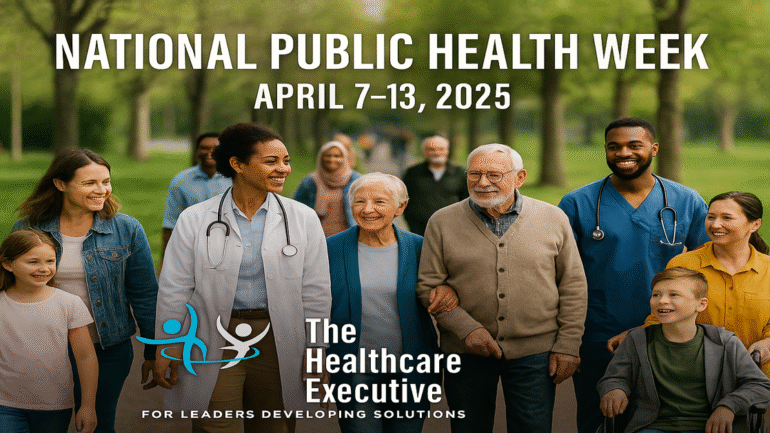National Public Health Week – April 7–13, 2025

- Posted by Greg Wahlstrom, MBA, HCM
- Posted in Health Observance Calendar
Uniting Communities and Healthcare Leaders for a Healthier Nation
Published: April 7, 2025
Each April, National Public Health Week invites healthcare professionals, leaders, and communities to reflect on the systems that shape population health. Public health is not merely a policy discipline—it is the foundation of community resilience, wellness equity, and proactive care. From clean water access to chronic disease prevention, the contributions of public health infrastructure are often invisible until they fail. This week reminds us of the urgent need to invest in preventive strategies and cross-sector partnerships that improve long-term outcomes. For healthcare executives, the observance presents a chance to align hospital priorities with broader community health needs. Initiatives such as mobile screening units, community-based vaccination drives, and upstream risk interventions are strategic imperatives. By focusing on population-level metrics, systems can move from episodic care toward sustainable, value-driven models. At Temple University’s College of Public Health, programs integrate clinical training with public health leadership to shape the next generation of system stewards. The future of health depends on how well we respond to public need—not just individual treatment.
The COVID-19 pandemic was a sobering reminder of the fragility and interdependence of public health systems. It exposed long-standing inequities and fractured infrastructures, while highlighting the critical role hospitals play in public health emergency response. National Public Health Week 2025 calls on leaders to reflect on those lessons and build systems that are more inclusive, data-driven, and resilient. The modern health executive must bridge clinical care and community outreach in a unified vision. This includes strategic investments in telehealth, community health worker programs, and behavioral health integration. Local governments and hospital boards must collaborate to map health disparities using tools like CDC’s PLACES platform. These resources enable targeted interventions and evidence-based policy development. In cities like Denver, Denver Health’s Public Health Institute serves as both a medical provider and a hub for addressing social determinants of health. Such dual-capacity systems illustrate what is possible when executive leadership takes a proactive stance. The power of public health lies not in reaction—but in readiness.
Hospitals must go beyond compliance and become champions of community health equity. Executive teams should incorporate social needs assessments into strategic planning cycles and budget forecasts. These assessments reveal root causes—housing, transportation, education—that shape health outcomes far more than clinical intervention alone. By investing in upstream partnerships with local nonprofits, schools, and housing agencies, hospitals can extend their impact and reduce avoidable readmissions. As highlighted in our health equity strategy guide, the most effective systems embed equity into every operational layer—from vendor selection to discharge protocols. Hospital CEOs must also take a stand on legislative issues that affect public health funding, Medicaid expansion, and environmental protections. Public health leadership requires more than data—it demands advocacy. By building coalitions that include civic leaders, patient voices, and frontline clinicians, executives can enact durable change. National Public Health Week is not just about honoring professionals in the field—it’s about activating leadership across the board. Action is the antidote to disparity.
Workforce development is another strategic pillar of public health transformation. Health systems need professionals trained in both clinical excellence and population health thinking. This requires interdisciplinary models that unite nursing, medicine, epidemiology, informatics, and administration. Leadership development programs should emphasize policy fluency, equity frameworks, and systems thinking. Initiatives like TRAIN Learning Network offer free continuing education to build public health competencies within hospital teams. Hospital systems that prioritize public health hiring pipelines—from internships to residency placements—will be better positioned to lead in times of crisis. Furthermore, boards should recruit from public health backgrounds to ensure executive decisions reflect population-level awareness. Just as hospitals invest in clinical innovation, they must also invest in community-focused leadership pipelines. These forward-thinking strategies will strengthen the link between bedside care and neighborhood outcomes. The next generation of public health champions must be developed today, not tomorrow. Systems that wait for disruption to act will find themselves too late.
As we celebrate National Public Health Week 2025, healthcare leaders must ask one important question: Are we truly serving the whole community, or only those who come through our doors? The answer requires honest appraisal of metrics, mission alignment, and executive priorities. Strategic community engagement, multisector collaboration, and transparent reporting must be normalized across hospital networks. This includes publishing Community Health Needs Assessments, tracking health equity benchmarks, and sharing success stories openly. Leaders should also recognize the mental health toll that public health crises take on healthcare workers and build internal support systems to sustain workforce resilience. Let this week serve not just as celebration, but as call to action. Public health cannot be an afterthought in a system designed to heal—it must be the framework upon which healing begins. From boardrooms to breakrooms, leadership must align around the idea that health is not created in hospitals alone. It is created in communities, one partnership at a time. Public health is everyone’s responsibility—and this week, that responsibility becomes visible.
Discover More: Explore executive strategies to drive equitable population health and resilient community systems.
Internal Links
- Advancing Health Equity Through Strategic Initiatives
- Rebuilding Trust in U.S. Healthcare: A Leadership Blueprint



